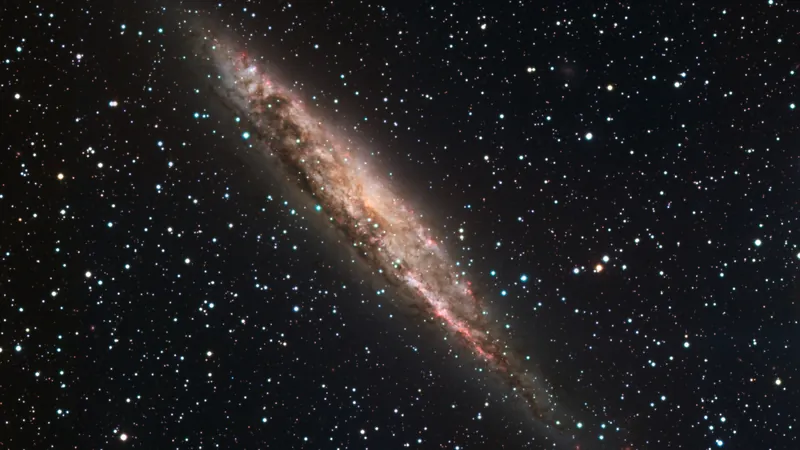
Unveiling the Cosmic Enigma: Meet 'Punctum,' the Mysterious Powerhouse Igniting Astronomical Curiosity
2025-08-12
Author: John Tan
Scientists Stumble Upon an Astounding Cosmic Mystery
In an extraordinary twist of fate, astronomers have unearthed a groundbreaking celestial object nestled within the neighboring galaxy NGC 4945, located a mere 11 million light-years away from our Milky Way. Dubbed 'Punctum'—Latin for "point"—this enigma is being hailed as a potential new category of astrophysical marvel that challenges everything we understand about the universe.
A Discovery to Remember
Elena Shablovinskaia, a leading astronomer from the Instituto de Estudios Astrofísicos at the Universidad Diego Portales in Chile, discovered Punctum utilizing the cutting-edge ALMA (Atacama Large Millimeter/submillimeter Array). According to Shablovinskaia, this intriguing object is not just an anomaly; outside the realm of supermassive black holes, it radiates mind-boggling energy unlike anything seen before.
A Luminosity That Astonishes
Punctum's luminosity is staggering—estimated to be from 10,000 to 100,000 times brighter than typical magnetars and about 100 times brighter than microquasars. It outshines nearly every supernova known, except for the legendary Crab Nebula. However, here's the catch: Punctum is only detectable in millimeter radio wavelengths, evading observation in visible or X-ray light, amplifying its mystery.
What Are We Looking At?
Despite numerous observations throughout 2023 confirming its consistent brightness—indicating that it isn’t a transient phenomenon—scientists are still speculating about its true nature. While millimeter-wave radiation is often associated with cold cosmic objects like protoplanetary disks, Punctum's characteristics suggest a more complex origin.
The Synchrotron Radiation Conundrum
The polarization of Punctum's millimeter light points to a highly structured magnetic field, leading researchers to suspect it might be contributing synchrotron radiation, typically produced by charged particles spiraling around magnetic fields. While some theorize it could be linked to a magnetar, pulsars are generally less luminous at these wavelengths, casting uncertainty on this hypothesis.
A Cosmic Puzzle Yet to Be Solved
Shablovinskaia asserts that Punctum stands apart in its uniqueness; it doesn't fit neatly within any established astronomical classification. Whether it’s an extreme version of a known object or an entirely new phenomenon remains to be seen. What we do know is that without the sensitivity of ALMA, this mysterious object would likely have gone unnoticed.
Looking Ahead: Future Discoveries Await
There’s no shortage of anticipation regarding follow-up observations with ALMA, which could provide clearer insights into Punctum's characteristics without the interference of brighter cosmic neighbors. Moreover, the James Webb Space Telescope (JWST) could serve as a key player; its high-resolution capabilities might reveal whether this cosmic mystery involves dust and emission lines beyond simple synchrotron radiation.
The Adventure Continues
For now, astronomers are left with more questions than answers, but one thing remains crystal clear: Punctum is a thrilling glimpse into the myriad mysteries still waiting to be unearthed in the cosmos. As Shablovinskaia puts it, "There is still a lot to discover in the millimeter sky."


 Brasil (PT)
Brasil (PT)
 Canada (EN)
Canada (EN)
 Chile (ES)
Chile (ES)
 Česko (CS)
Česko (CS)
 대한민국 (KO)
대한민국 (KO)
 España (ES)
España (ES)
 France (FR)
France (FR)
 Hong Kong (EN)
Hong Kong (EN)
 Italia (IT)
Italia (IT)
 日本 (JA)
日本 (JA)
 Magyarország (HU)
Magyarország (HU)
 Norge (NO)
Norge (NO)
 Polska (PL)
Polska (PL)
 Schweiz (DE)
Schweiz (DE)
 Singapore (EN)
Singapore (EN)
 Sverige (SV)
Sverige (SV)
 Suomi (FI)
Suomi (FI)
 Türkiye (TR)
Türkiye (TR)
 الإمارات العربية المتحدة (AR)
الإمارات العربية المتحدة (AR)